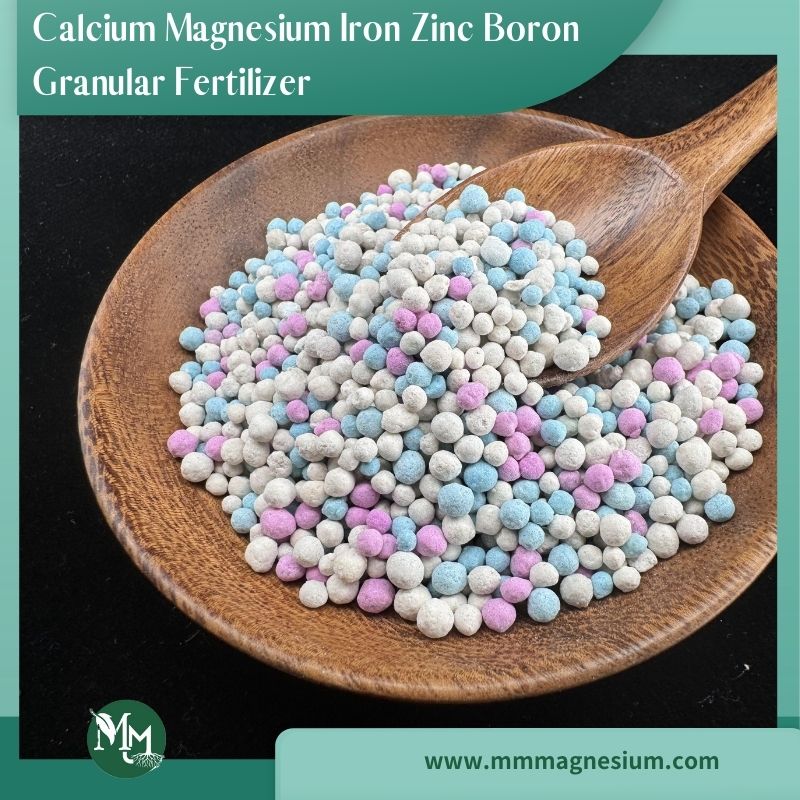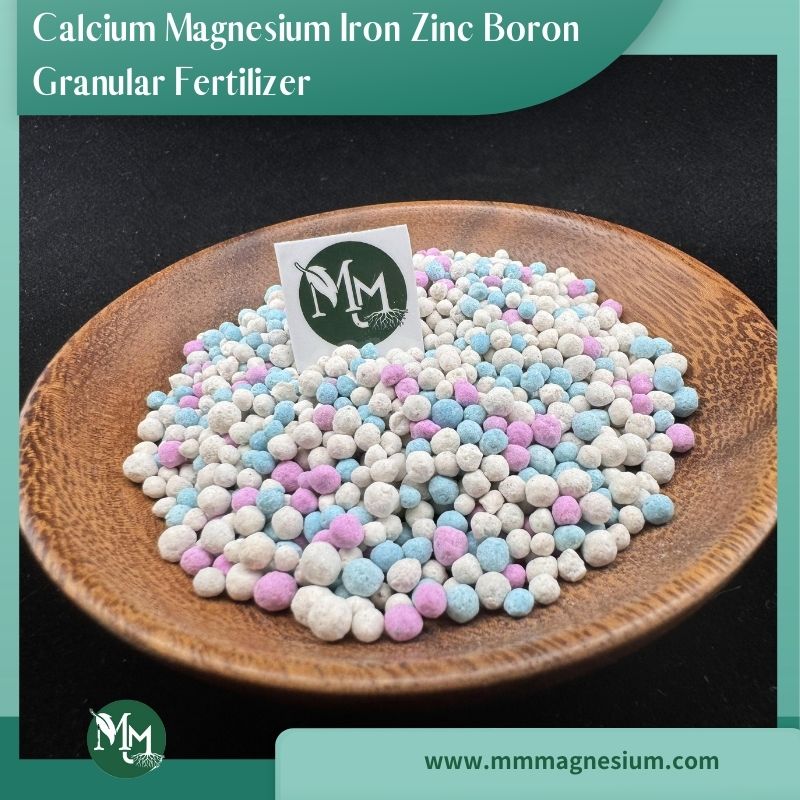

Mg≥15%
Ca≥20%
Fe≥1%
Zn2%
B≥1.5%
Granular size:2-4mm
Applicable crops: Fruit trees, vegetables, rice, wheat, corn and other food crops, cotton, tea, tobacco and other cash crops.




Yingkou Maomei Agricultural Technology Co., Ltd., relying on high-quality mineral resources, produces calcium magnesium iron zinc boron fertilizer products with advanced technology and the following characteristics:
Products are exported to the United States, Russia, Indonesia, Canada, Spain, Malaysia, Bangladesh, and other countries, and also cover all provinces, cities, and regions across the country.
For more service advantages of Yingkou Maomei Agricultural Technology, please see Why choose us? and Factory Photos.
Advantages of Calcium Magnesium Iron Zinc Boron Fertilizer
Calcium magnesium iron zinc boron granular fertilizer is a composite trace element fertilizer containing calcium (Ca), magnesium (Mg), iron (Fe), zinc (Zn) and boron (B). Each element plays an important role in plant growth and development. The following are the main functions of these elements:
1. Calcium (Ca)
Cell wall structure: Calcium is an important component of plant cell walls and can enhance the stability and structural strength of cell walls.
Root development: Promote root growth and enhance root absorption capacity.
Improve disease resistance: Enhance plant resistance to diseases and reduce the occurrence of diseases.
2. Magnesium (Mg)
Chlorophyll synthesis: Magnesium is the core element of chlorophyll molecules and is essential for photosynthesis.
Enzyme activation: Participate in the activation of multiple enzymes and promote plant metabolism.
Enhance photosynthesis: Improve plant photosynthesis efficiency and promote growth and development.
3. Iron (Fe)
Chlorophyll synthesis: Iron is a necessary element for chlorophyll synthesis, and iron deficiency will cause leaf yellowing.
Respiration: Participate in the cellular respiration process and improve energy metabolism efficiency.
Enzyme function: As a cofactor of many enzymes, it participates in the transport and storage of oxygen.
4. Zinc (Zn)
Composition of enzymes: Zinc is a component or activator of many enzymes and participates in the metabolic process of plants.
Growth regulation: It affects the synthesis of plant hormones (such as auxin) and regulates growth and development.
Stress resistance: It improves the stress resistance of plants and enhances their resistance to cold, drought and disease.
5. Boron (B)
Cell wall formation: Boron plays an important role in the formation of cell walls and cell division.
Carbohydrate transport: It participates in the synthesis and transport of carbohydrates and affects the flowering and fruiting of plants.
Promoting reproductive growth: It plays an important role in pollen tube growth and seed development. Boron deficiency can cause flowers without fruits or deformed fruits.
Comprehensive effect
Comprehensive nutrition: Calcium magnesium iron zinc boron granular fertilizer provides a variety of essential trace elements, ensures the comprehensive nutrition supply of plants, and prevents various deficiency diseases.
Improve yield and quality: By improving the growth environment and nutritional status of plants, it can significantly improve the yield and quality of crops, such as increasing the size, color and taste of fruits.
Enhance stress resistance: Improve the resistance of plants to various adverse environmental conditions (such as drought, cold, pests and diseases, etc.) and reduce losses.
Promote healthy growth: Comprehensively provide trace elements required for growth to promote the healthy growth of roots, stems, leaves and fruits.

Fertilization Recommendations
The following are general recommended dosages. The specific dosage should be adjusted according to soil test results and crop needs:
Fruit trees:
Application amount per fruit tree: 100-200 grams, applied twice, the first time in the spring budding period, the second time in the fruit expansion period. Application method: ring ditch application or hole application, cover with soil and water after application.
Vegetables:
Application amount per square meter: 20-40 grams, applied in stages according to the growth period of vegetables, it is recommended to apply a base fertilizer before sowing or transplanting, and apply once during the growth period. Application method: spread and then plow into the soil or flush with water.
Grain crops:
Application amount per mu: 1-2 kilograms, it is recommended to apply a base fertilizer before sowing or seedling stage, and apply once during the key growth period (such as jointing stage, heading stage). Application method: spread and then plow into the soil or flush with water.
Economic crops:
Application amount per mu: 1-2 kilograms, the application time and frequency depend on the specific crop, generally applied once during the seedling stage, flowering stage and fruit development stage. Application method: broadcasting, hole application or flushing with water.

1. Protect from rain and sunlight, store in a ventilated and dry place, and do not transport or store together with toxic and hazardous substances.
2. Each bag is 25 kg, and we can also provide packaging as small as 1 kg or as large as ton bags according to customer requirements.
3. Plastic woven bags, lined with plastic inner bags. We provide all available packaging such as paper plastic bags/kraft paper bags/PE bags.
4. We provide a variety of transportation methods: road transportation, railway transportation, air transportation, container transportation, and ocean transportation.
5. Our company's marks can provide OEM or neutral marks.

FAQ
1.What is the color of the fertilizer?
The color of our fertilizers varies depending on the product type and formulation. Usually, our fertilizers are in powder or granular form and may be white, gray, brown or black. These colors are caused by the different ingredients and additives contained in the fertilizers and do not affect the quality and effect of the product.
2.Can I get samples?
Yes, we are happy to provide you with samples. You can try our products first to confirm whether they meet your needs. Please provide your contact details and address so that we can arrange to send samples.

Product Knowledge:Color of Granular Fertilizer

The pigments used to color fertilizer pellets are usually non-toxic, stable, and environmentally friendly chemicals. The specific ingredients include inorganic pigments, organic pigments, food-grade dyes, natural pigments, etc. The main functions of color on fertilizer pellets are as follows:
1. Identification and differentiation
Identify different types of fertilizers: Fertilizer manufacturers often color fertilizers of different types or formulations so that farmers and users can easily identify them. For example, nitrogen fertilizers, phosphate fertilizers, potash fertilizers, or compound fertilizers may use different colors. During storage and use, fertilizers of different colors can help users avoid confusion and ensure correct application.
2. Improve appearance and market appeal
Colored fertilizer pellets look more uniform and beautiful, which helps to improve the market appeal of the product. Color can become part of the brand, helping consumers remember and identify a brand of products.
3. Functional needs
During the fertilization process, colored fertilizer pellets are easier to see, helping farmers monitor the fertilization and ensure uniform distribution. Use color to distinguish the type and amount of fertilizer to avoid fertilizer waste or plant damage due to improper application.
4. Anti-counterfeiting and protection
Some manufacturers use specific colors or color combinations to prevent counterfeit products from entering the market. In some cases, color may also have a certain protective effect to prevent certain ingredients from degrading under light.
5. Safety and warning
Warning effect: Some toxic or potent fertilizers are marked with specific colors to remind users to pay attention to safety when using them and avoid accidental ingestion or misuse.
Yingkou Maomei Agricultural Technology Co., Ltd
Name: Brenda
Mobile:86-188-7490-2028
Tel:86-400-699-8826
Whatsapp:86-18874902028
Email:info@maomeimg.com
Add:Qianjia Village, Nanlou Economic Development Zone, Yingkou City, Liaoning Province, China